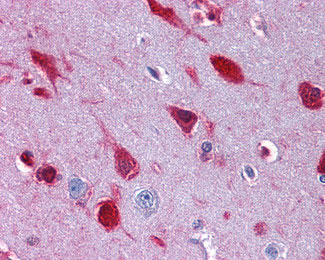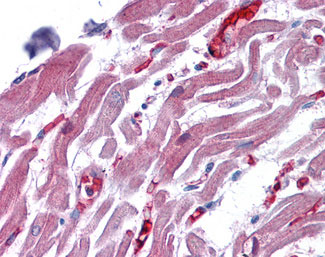MRNP41 / RAE1 Antibody (C-Terminus)
Goat Polyclonal Antibody
- SPECIFICATION
- CITATIONS
- PROTOCOLS
- BACKGROUND

Application
| WB, IHC-P, E |
|---|---|
| Primary Accession | P78406 |
| Reactivity | Human, Mouse, Rat, Rabbit, Zebrafish, Hamster, Monkey, Pig, Chicken, Horse, Xenopus, Bovine, Dog |
| Host | Goat |
| Clonality | Polyclonal |
| Calculated MW | 41kDa |
| Dilution | ELISA (1:64000), IHC-P (3.75 µg/ml), WB (0.03-0.1 µg/ml) |
| Gene ID | 8480 |
|---|---|
| Other Names | mRNA export factor, Rae1 protein homolog, mRNA-associated protein mrnp 41, RAE1, MRNP41 |
| Target/Specificity | Human RAE1. NP_003601and NP_001015885 represent identical proteins. |
| Reconstitution & Storage | Store at -20°C. Minimize freezing and thawing. |
| Precautions | MRNP41 / RAE1 Antibody (C-Terminus) is for research use only and not for use in diagnostic or therapeutic procedures. |
| Name | RAE1 |
|---|---|
| Synonyms | MRNP41 |
| Function | Acts as a mRNA export factor involved in nucleocytoplasmic transport (PubMed:20498086, PubMed:33849972). Plays a role in mitotic bipolar spindle formation (PubMed:17172455). May function in attaching cytoplasmic mRNPs to the cytoskeleton both directly or indirectly (PubMed:17172455). |
| Cellular Location | Cytoplasm. Nucleus. Cytoplasm, cytoskeleton, spindle pole. Nucleus envelope. Note=Recruited from interphase nuclei to spindle MTs during mitosis. |

Thousands of laboratories across the world have published research that depended on the performance of antibodies from Abcepta to advance their research. Check out links to articles that cite our products in major peer-reviewed journals, organized by research category.
info@abcepta.com, and receive a free "I Love Antibodies" mug.
Provided below are standard protocols that you may find useful for product applications.
Background
Binds mRNA. May function in nucleocytoplasmic transport and in directly or indirectly attaching cytoplasmic mRNPs to the cytoskeleton.
References
Bharathi A.,et al.Gene 198:251-258(1997).
Kraemer D.M.,et al.Proc. Natl. Acad. Sci. U.S.A. 94:9119-9124(1997).
Lu L.,et al.Submitted (JUL-2003) to the EMBL/GenBank/DDBJ databases.
Ota T.,et al.Nat. Genet. 36:40-45(2004).
Deloukas P.,et al.Nature 414:865-871(2001).
If you have used an Abcepta product and would like to share how it has performed, please click on the "Submit Review" button and provide the requested information. Our staff will examine and post your review and contact you if needed.
If you have any additional inquiries please email technical services at tech@abcepta.com.













 Foundational characteristics of cancer include proliferation, angiogenesis, migration, evasion of apoptosis, and cellular immortality. Find key markers for these cellular processes and antibodies to detect them.
Foundational characteristics of cancer include proliferation, angiogenesis, migration, evasion of apoptosis, and cellular immortality. Find key markers for these cellular processes and antibodies to detect them. The SUMOplot™ Analysis Program predicts and scores sumoylation sites in your protein. SUMOylation is a post-translational modification involved in various cellular processes, such as nuclear-cytosolic transport, transcriptional regulation, apoptosis, protein stability, response to stress, and progression through the cell cycle.
The SUMOplot™ Analysis Program predicts and scores sumoylation sites in your protein. SUMOylation is a post-translational modification involved in various cellular processes, such as nuclear-cytosolic transport, transcriptional regulation, apoptosis, protein stability, response to stress, and progression through the cell cycle. The Autophagy Receptor Motif Plotter predicts and scores autophagy receptor binding sites in your protein. Identifying proteins connected to this pathway is critical to understanding the role of autophagy in physiological as well as pathological processes such as development, differentiation, neurodegenerative diseases, stress, infection, and cancer.
The Autophagy Receptor Motif Plotter predicts and scores autophagy receptor binding sites in your protein. Identifying proteins connected to this pathway is critical to understanding the role of autophagy in physiological as well as pathological processes such as development, differentiation, neurodegenerative diseases, stress, infection, and cancer.



